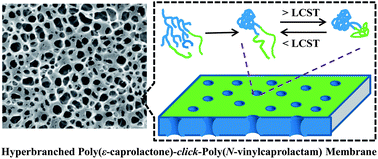Hyperbranched polycaprolactone-click-poly(N-vinylcaprolactam) amphiphilic copolymers and their applications as temperature-responsive membranes†
Abstract
Hyperbranched poly(ε-caprolactone) with peripheral terminal alkyne groups (HPCL) was synthesized via thiol–yne click reaction among the AB2-type α-thiol–ω-alkyne–poly(ε-caprolactone) (CH![[triple bond, length as m-dash]](https://www.rsc.org/images/entities/char_e002.gif) C–PCL–SH) linear precursors. Azide-terminated poly(N-vinylcaprolactam) (PVCL–N3), prepared a priori via xanthate-mediated reversible addition–fragmentation chain transfer (RAFT) polymerization of N-vinylcaprolactam (VCL), was then linked to HPCL chains through Cu(I)-catalyzed alkyne–azide click reaction. The resultant hyperbranched–linear HPCL-click-PVCL copolymers were cast, by phase inversion in an aqueous medium, into microporous membranes of well-defined and uniform pores. The PVCL content in the HPCL-click-PVCL copolymers could be used to control the pore size and porosity of the resulting membranes. The temperature-responsive characteristics of the HPCL-click-PVCL membranes were illustrated in the swelling behavior and controlled drug transport through the membranes. These stimuli responsive membranes with controllable morphology, improved mechanical properties and negligible cytotoxicity are useful as biomaterials for controlled drug delivery.
C–PCL–SH) linear precursors. Azide-terminated poly(N-vinylcaprolactam) (PVCL–N3), prepared a priori via xanthate-mediated reversible addition–fragmentation chain transfer (RAFT) polymerization of N-vinylcaprolactam (VCL), was then linked to HPCL chains through Cu(I)-catalyzed alkyne–azide click reaction. The resultant hyperbranched–linear HPCL-click-PVCL copolymers were cast, by phase inversion in an aqueous medium, into microporous membranes of well-defined and uniform pores. The PVCL content in the HPCL-click-PVCL copolymers could be used to control the pore size and porosity of the resulting membranes. The temperature-responsive characteristics of the HPCL-click-PVCL membranes were illustrated in the swelling behavior and controlled drug transport through the membranes. These stimuli responsive membranes with controllable morphology, improved mechanical properties and negligible cytotoxicity are useful as biomaterials for controlled drug delivery.


 Please wait while we load your content...
Please wait while we load your content...